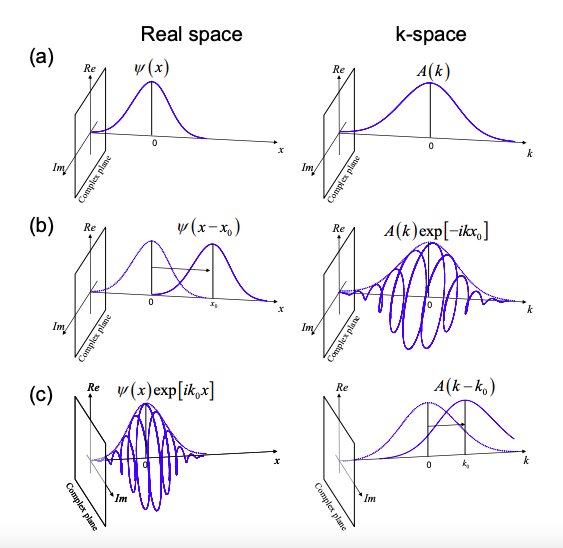1.11: Ejemplos de paquetes de ondas
- Page ID
- 84446
\( \newcommand{\vecs}[1]{\overset { \scriptstyle \rightharpoonup} {\mathbf{#1}} } \) \( \newcommand{\vecd}[1]{\overset{-\!-\!\rightharpoonup}{\vphantom{a}\smash {#1}}} \)\(\newcommand{\id}{\mathrm{id}}\) \( \newcommand{\Span}{\mathrm{span}}\) \( \newcommand{\kernel}{\mathrm{null}\,}\) \( \newcommand{\range}{\mathrm{range}\,}\) \( \newcommand{\RealPart}{\mathrm{Re}}\) \( \newcommand{\ImaginaryPart}{\mathrm{Im}}\) \( \newcommand{\Argument}{\mathrm{Arg}}\) \( \newcommand{\norm}[1]{\| #1 \|}\) \( \newcommand{\inner}[2]{\langle #1, #2 \rangle}\) \( \newcommand{\Span}{\mathrm{span}}\) \(\newcommand{\id}{\mathrm{id}}\) \( \newcommand{\Span}{\mathrm{span}}\) \( \newcommand{\kernel}{\mathrm{null}\,}\) \( \newcommand{\range}{\mathrm{range}\,}\) \( \newcommand{\RealPart}{\mathrm{Re}}\) \( \newcommand{\ImaginaryPart}{\mathrm{Im}}\) \( \newcommand{\Argument}{\mathrm{Arg}}\) \( \newcommand{\norm}[1]{\| #1 \|}\) \( \newcommand{\inner}[2]{\langle #1, #2 \rangle}\) \( \newcommand{\Span}{\mathrm{span}}\)\(\newcommand{\AA}{\unicode[.8,0]{x212B}}\)
Un paquete de ondas gaussiano típico se muestra en la Figura 1.11.1 tanto en sus representaciones de espacio real como de espacio k. Inicialmente la distribución de probabilidad se centra en x = 0 y k = 0. Si cambiamos el paquete de ondas en el espacio k a un valor promedio\(\langle k\rangle = k_{0}\), esto equivale a multiplicar por un factor de fase\(\text{ exp}[ik_{0}x]\) en el espacio real. De manera similar, desplazar el centro del paquete de ondas en el espacio real a\(\langle x\rangle = x_{0}\) es equivalente a multiplicar la representación k-espacio por un factor de fase\(\text{ exp}[ikx_{0}]\).
| Coordenadas reales (x, t) | \(\rightleftharpoons\) | Coordenadas inversas (k,\(\omega\)) |
|---|---|---|
| turno por\(x_{0}\) | \ (\ derechaderpoones izquierdos\) ">\(\rightleftharpoons\) | \ (\ omega\)) ">\(\times \text{ exp}[-ikx_{0}]\) |
| \(\times \text{ exp}[ik_{0}x]\) | \ (\ derechaderpoones izquierdos\) ">\(\rightleftharpoons\) | \ (\ omega\)) ">cambiar por\(k_{0}\) |
| turno por\(t_{0}\) | \ (\ derechaderpoones izquierdos\) ">\(\rightleftharpoons\) | \ (\ omega\)) ">\(\times \text{ exp}[i\omega t_{0}]\) |
| \(\times \text{ exp}[-i\omega_{0}t]\) | \ (\ derechaderpoones izquierdos\) ">\(\rightleftharpoons\) | \ (\ omega\)) ">cambiar por\(\omega_{0}\) |



